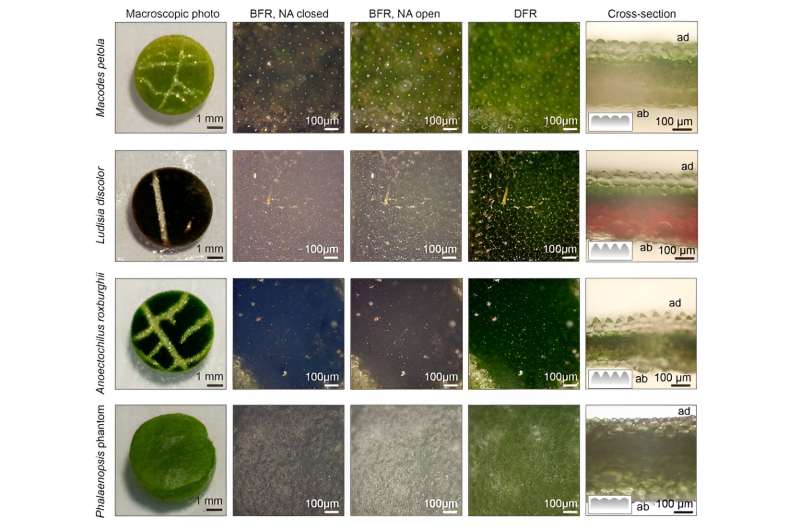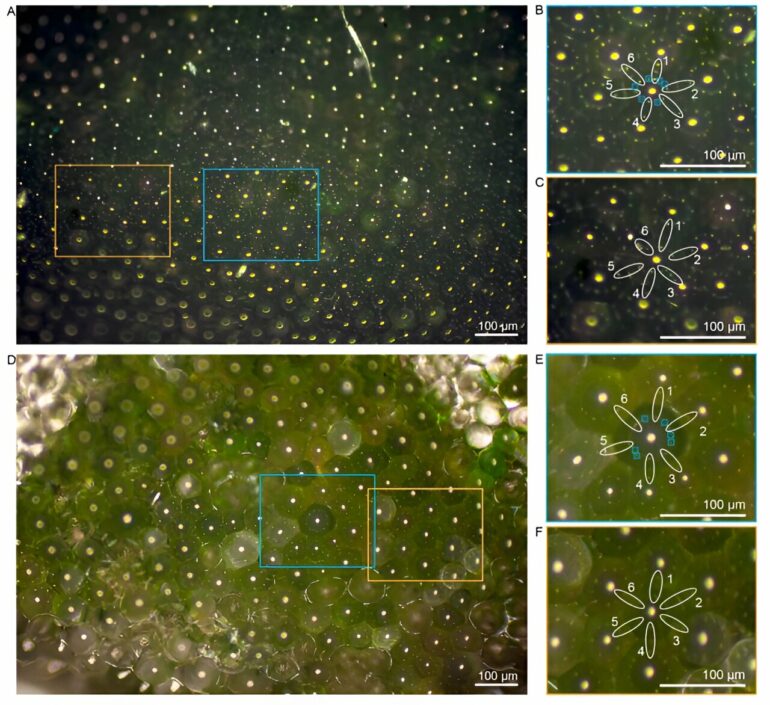Solar panels work great in full sunlight conditions, but many regions have little sunlight on any given day, meaning there is less energy generated than needed. Now Tufts researchers have discovered that a particular type of jewel orchid, which thrives in low-light conditions, might offer a key to solving this problem.
School of Engineering faculty members Giulia Guidetti and Fiorenzo Omenetto report, in a paper appearing in Advanced Optical Materials, that the leaves of the Macodes petola jewel orchid are made up of dome-like cells that allow them to capture more than three times as much light as ordinary plant “skin” cells, and share that light with neighboring cells, acting essentially as an optical network.
That networking process maximizes the light that the plant can use to convert sunlight to chemical energy, essential for its functioning.
The researchers copied those cell patterns using a silk-protein-based biomaterial, mimicking the light harvesting and optical networking capabilities of the orchid, and suggest that solar panels made of such a material “would go beyond the flexible solar cells that exist today,” says Omenetto, Frank C. Doble Professor of Engineering and director of Silklab at Tufts.
Now Guidetti, a research assistant professor in the Department of Biomedical Engineering, and Omenetto have received a grant to further investigate the plant light harvesting systems and the possibility of applying those systems’ optical networks to advance solar energy efficiency.
An intriguing pattern
Guidetti stumbled on the plant’s special properties. During the pandemic, she says, she bought many houseplants, attracted especially to ones with shiny, metallic-appearing leaves, and got interested in what made them that way.
“I put them under the microscope, and saw that their leaf surfaces were not flat, like ordinary leaves, and that they had a micro pattern,” she says. “It was all curiosity driven.”
Plants take sunlight and convert it into glucose—a form of energy that sustains all of life on Earth. The epidermal—or skin—cells of plants are responsible for taking in the sunlight.
Botany reports had already noted the conical shape of those cells in some jewel orchids, with the suggestion that they might improve the efficiency of concentrating light to maximize conversion to energy, necessary for a plant that exists in nature in low-light conditions.
But other researchers had not looked into how the cell shape and arrangement might affect its ability to photosynthesize the light energy, Guidetti and Omenetto say in their paper.

Optical response of the leaves of plants from the Orchidaceae genus: Macodes petola, Ludisia discolor, Anoectochilus roxburghii, and Phalenopsis phantom (common orchid). © Advanced Optical Materials (2024). DOI: 10.1002/adom.202401729
Looking very closely at the Macodes petola jewel orchids, they found the surface cells not to be flat or cone-like, as many plants are, but more like domes, says Guidetti, who is deputy director of the Silklab.
“The way we think it’s working is that light is coming from the top, and instead of being just focused inside the leaf where the chloroplasts are, the presence of the domes basically enables the light to be spread over the surface of the leaf, allowing also for non-directly illuminated cells to carry out photosynthesis, thus resulting in an overall higher photoconversion efficiency,” she says.
Copying nature’s patterns
After mapping the types of surface cells, their connections, and their variability, the researchers decided to copy it. They applied a thin layer of a silicon polymer to the surface of the leaves, forming a negative replica of the surface of the leaves. Then they poured a clear silk protein mix onto that, creating an exact copy of the microscopic shape of the cell patterns on the leaves.
Silk, produced by silkworms and then processed into a water-based solution, has been used by Omenetto and other Silklab researchers to make a very wide range of products, from resorbable electronics to biocompatible sensors. Silk is also commercially available at scale, with some half a million tons a year produced at silkworm farms, Omenetto says.
The silk-based version of the leaf “faithfully reproduced” the round shape of the plant cells along with their hexagonal arrangement and the “cross-communication seen between neighboring cells when illuminated with visible light, similarly to that observed in the plant leaves,” the researchers write.
Guidetti and Omenetto added a dye to the silk material used in the replica plant leaves, allowing them to track light as it moved from cell to cell. The biomaterial also mimics the curves and floppiness of the leaves, which again allow for greater access to light and ability to distribute light across the leaf.
“Such plant-based living optical networks could serve as a source of inspiration for the design of functional materials that efficiently harvest, manipulate, and process light with material formats that are soft, conformal, and sustainable, as preliminarily demonstrated by replicating the living structure of the leaf,” Guidetti and Omenetto write.
This is “the first demonstration of optical networks in a living system, because something like that has not been reported before in any plant of anyone as far as we know—a system that can manage the light through an orderly assembly of lenses of cells,” adds Omenetto.
The researchers are currently screening other plants in the jewel orchid family, comparing the shapes of the plant cells to those that exist in medium and high light conditions, and fabricating replicas of the structure of the leaves, looking for plants that might be able to capture light even more efficiently.
They also plan to experiment to see if changing the lighting conditions that the jewel orchids experience might change how the light-sharing network works.
More information:
Giulia Guidetti et al, Discovery of Living Optical Networks in Orchid Leaves as Inspiration for Light Harvesting and Redistribution in Soft, Curvilinear Material Formats, Advanced Optical Materials (2024). DOI: 10.1002/adom.202401729
Citation:
Could a plant guide the design of next-generation solar panels? (2024, August 8)



